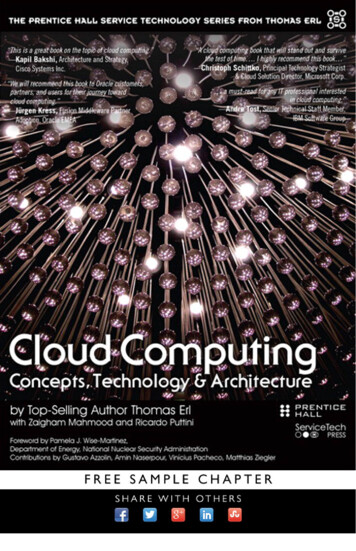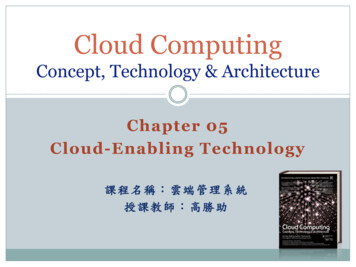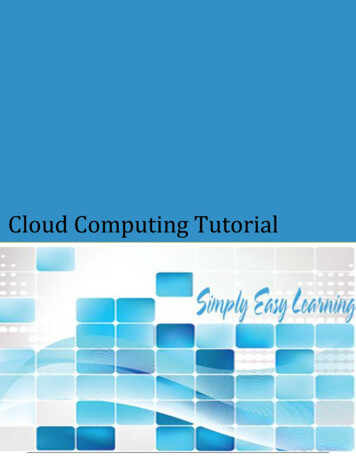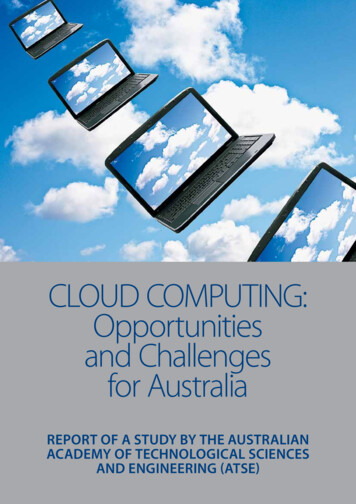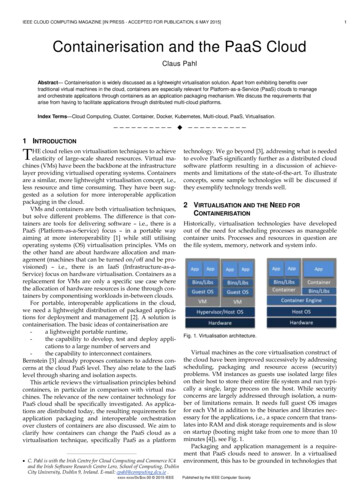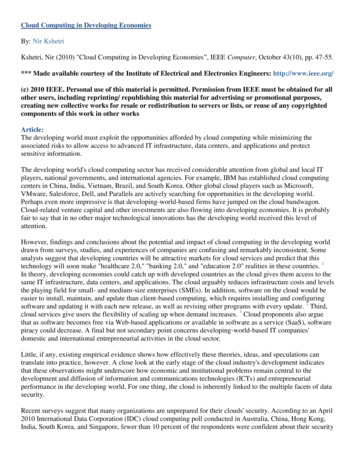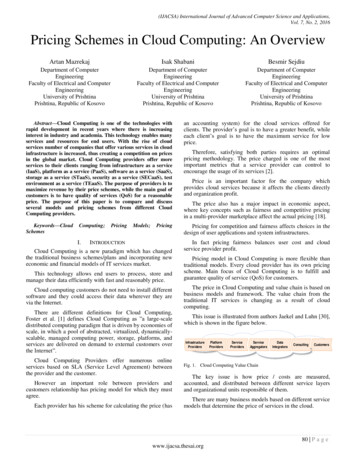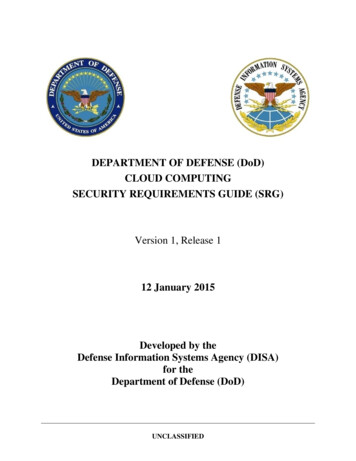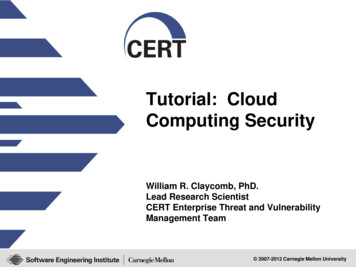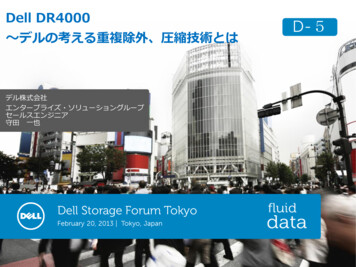
Transcription
5Cloud Computing5.1Introduction“If computers of the kind I have advocated become the computers of the future, thencomputing may someday be organised as public utility just as the telephone system is apublic utility. The computer utility could become the basis of a new and important industry.”– John McCarthy 19611.McCarthy’s vision took almost half a century to realise. Today, computing as a public utilitytakes the form of cloud computing and epitomise how businesses demand IT be delivered.The National Institute of Standards and Technology (NIST) defines Cloud Computing as“a model for enabling ubiquitous, convenient, on-demand network access to a shared pool ofconfigurable computing resources (e.g., networks, servers, storage, applications andservices) that can be rapidly provisioned and released with minimal management effort orservice provider interaction.”Cloud computing has certainly captured a great deal of attention and following over the pastthree years. IT giants like HP, IBM, Intel and Microsoft have evolved their business strategiesaround cloud computing. Traditional software houses like Microsoft and SAP are offeringtheir highly successful software suites as cloud services to address growing customerdemand for utility based charging and collaboration. “cloud computing” is reiterated on adaily basis in both IT and business news. The theme was mentioned in varying degrees in 71of 77 Gartner’s hype cycles for 2011 with 3 of them dedicated to different aspect of cloudcomputing. Forrester Research estimated the global market size for cloud computing to beUS 241billion by 2020. Public cloud will constitute two-thirds of that market size, orUS 159.3billion.5.2Market Trends5.2.1 Sheer Volume of Content TransferredThe sheer volume of content to be transferred, due to ubiquity of access and demand formedia, will strain any unoptimised content delivery mechanism. Since online presence iscritical to businesses today, the need to deliver contents quickly and in time to theircustomers will continue to be a priority.Nokia Siemens Networks predicts that broadband data will increase 1,000 fold by 2020.Cicso also projected 90% compound annual growth rate (CAGR) of global traffic for videoand 65% for data through 2016. Both projections outpace Moores Law so the delivery ofcontent in the long term cannot be fulfilled simply by buying better servers. Content deliveryand server utilisation must be optimised to satisfy that demand for information.The types of content transferred will also expand with different sources like intelligent,networked devices (Internet of Things) and contextual data, to processed information andinteractive media (e.g. Internet TV). By 2014, 50% of all data would have been processed bycloud. Cloud computing and the global distribution of public clouds can provide that lastmile delivery.1Harold Abelson. Architects of the Information Society Thirty Five Years of the Laboratory for ComputerScience at MIT. U.S.A.: Wonder Book Publishing; 1999.1
5.2.2 Demand for “Instant Performance”Social analytics is increasingly common as a business strategy to better understand andrespond to the customer as an individual. The volume of data adds to the wealth ofelectronic records waiting to be analysed and combined for intelligence and better insightsinto the business. Businesses demand such insights with increasing immediacy.Demand for “instant performance” extends beyond the processing of data. Where IT couldtake months to provision a single server, it now faces competition from cloud and otherhosting providers that can do the same in minutes. It is not uncommon to hear stories ofbusiness units bypassing IT because public hosting and cloud providers can fulfil theirrequirements quicker.Casual supercomputers fulfill both the demand for faster turnaround time and a reductionof the cost of ownership. These compute behemoths are assembled solely for the computetask, are flexible in the amount of performance required, and are released once the task iscompleted. Cycle Computing made news with its 30,000 core cluster at a cost ofUS 1,279/hour. The cluster was constructed on-demand on Amazon Web Services and wastorn down eight hours later.5.2.3 Seamless Experience from Personal Cloud and BYODIn Singapore, 30% of organisations have implemented cloud computing to address the needarising from consumer devices. The ubiquity of an untethered Internet and affordability ofpowerful, easy-to-use devices has driven productivity as executives stay connected to thecompany anytime, anywhere and using any device.Figure 1: Frictionless Sync Defines the Consumer Cloud ExperienceAs with the proliferation of the Internet, the advent of personal clouds represents a tectonicshift in the personalisation of IT. The seamless experience and integration of data, social and2
communication services into a single smart device will be the new benchmark for corporateIT offerings.Smarter mobile devices are replacing the laptop in providing a more convenient way toaccess information. It is not uncommon today to find business executives preferring themore mobile tablet devices to a full-featured laptop. Consistency of data across differentdevices will be a challenge IT departments need to resolve.Today, Android devices pull configuration and personal data from a user’s Google account.In a similar fashion, IOS devices share information using Apple’s iCloud; user data stored indropboxes can be accessed from any smart device. Automatic synchronisation of data acrosspersonal devices dilutes lockdown to a single device. Expectation of the same conveniencewill force IT to rethink what personal computing entails. Experience with the benefits of suchpersonal cloud services will increase both demand and acceptance of such services incorporations. Cloud services provide a natural avenue for enterprises to support theresulting myriad of devices and services.Advances both in technology and processes will address the current concerns andshortcomings of cloud computing, e.g. reliability, interoperability, security and privacy,service level enforceability, and predictability of charges. Such integration of technologywith process and policies, together with adoption of cloud standards, will position cloudcomputing for wider appeal.Insatiable compute demand of an ever data hungry world brought about by ubiquitous andfaster connectivity, the demand for “instant performance”, faster, more sophisticatedanalytics and more connected businesses, and extrapolation of the seamless integrationprovided by personal clouds with the personalisation of IT will stimulate cloud adoption.5.2.4 An Arduous Journey toward Cloud ComputingCloud computing does not just waive the cover charges. It outlines the underlyingarchitectures upon which services are designed and applies equally to utility computing andinternal corporate data centres. Cloud computing evolved from a myriad of technologiesincluding autonomic computing, grid computing, multi-tenancy, service orientedarchitecture (SOA) and (network, server and storage) virtualisation. It abstracts designdetails from the cloud user, presenting compute as an on-demand service. This sectionreminisces on the passage of the vision of “Compute as a Utility” to its realisation as “CloudComputing”.Since McCarthy’s lecture in 1961, several notable attempts have been made to redefine howcompute is used and delivered. The first virtual machine appeared with IBM’s CP/CPM thatwas productised as VM/370 in 1972. Back then, the issue of multi-tenancy was addressedeither as an integrated time-shared system with sophisticated segregation of privilegesbetween users, or with each user having his own computer walled within a virtual machine.By the mid 1980s, general interest in compute as a utility dipped to a low with the advent ofaffordable personal workstations that fulfilled most compute demands. Grid computing,coined in early 1990s, revived the concept that “compute should be accessible like anelectric power grid”. Landmark projects like SETI@home and Globus Toolkit in 1999 and1998 respectively laid the groundwork for tapping unused compute resources and3
synchronising these compute jobs. Grid computing was the precursor to coordinatingcompute in the cloud.By 2000, grid computing had taken off in research and development (R&D). IT vendors likeIBM, HP and Sun Microsystems started offering grid computing services. Most notably, SunMicrosystem started marketing Sun Cloud2 for US 1 per CPU/hour. This was the first timecompute was available commercially as a utility on a global scale. In a controversial articlepublished in the Harvard Business Review in 2003, Nicholas Carr declared, “IT does notmatter”. He posited that IT was becoming commoditised and would be delivered like otherutility services.Virtualisation technologies started gaining traction in 2005 as a means to improve datacentre efficiencies by consolidating workloads. Network, server, and storage virtualisationproviders collaborated to deploy autonomous technologies that enabled rapid provisioningof services in a virtualised data centre environment. This paved the way for the internalcorporate data centre to transit to cloud computing.In 2006, Amazon launched its Elastic Compute cloud (EC2) and Storage (S3) services thatoffered compute and storage rental with two distinct features. These services use a pricingmodel that charged “per use”, and services were provisioned (and released) within minutesof payment. Computing was now accessible as a utility.Amazon was soon followed by Google Apps that offered an office suite as a service, GoogleApp Engine that provides a J2EE platform charged by CPU cycle, Microsoft’s Azure platformservice, and a flurry of web hosting providers like Rackspace and 1and13. There was just asmuch interest in providing software that enables enterprises to run cloud services in theirinternal data centres. Examples include Joyent’s SmartOS, 3tera’s AppLogic, Microsoft’sWindows Azure, and OpenStack.In this surge of technologies, it is easy to forget that cloud computing is not entirely atechnology play. Many other adjacent advances, especially in IT management, are necessaryfor a successful cloud deployment. Efficiencies gained must be balanced against the loss ofcontrol. The relationship between IT organisations, their technology partners and IT’scustomers, must be managed through an effective IT governance structure.After an arduous 50 years of attempts with varying degree of success, John McCarthy’svision to organise compute as a public utility has finally been realised with cloud computing.The pervasion of IT into businesses and personal lives conduced the demand and reliance onIT, and the corresponding availability of IT expertise, into a global desire for compute ondemand. Additionally cloud computing allows data centre owners to realise many of itsbenefits by facilitating clouds to be built within their facilities. A vision born when computingresources were scarce and costly will be tested against today’s demand for increasinglyinstant results.23Wikipedia. Sun Cloud. [Online] Available from: http://en.wikipedia.org/wiki/Sun Cloud [Accessed 9th July2012].Linda Leung. More Web Hosts Moving to the Cloud. [Online] Available ssed 9th July 2012].4
5.2.5 Cloud Computing TodayThe National Institute of Standards and Technology (NIST) defines cloud computing as“a model for enabling ubiquitous, convenient, on-demand network access to a shared pool ofconfigurable computing resources (e.g., networks, servers, storage, applications andservices) that can be rapidly provisioned and released with minimal management effort orservice provider interaction.”5.2.6 Cloud Service ModelsNIST broadly categorises clouds into three service models: Cloud Software as a Service (SaaS). Consumers are given access to the provider’sapplications that runs on a cloud infrastructure. Examples of SaaS include Google’sGMail, Microsoft 365 and Salesforce.com. Consumers of these SaaS access theapplications using a variety of clients such as a Web browser or even a mobileapplication. Management of infrastructure, operating environment, platformservices, and application configuration are left to the cloud provider. Cloud Platform as a Service (PaaS). Consumers are given access to platform onwhich they can develop their custom applications (or host acquired applications).Google AppEngine, Microsoft Azure and Force.com are examples of PaaS.Consumers of PaaS launch their applications using the specific programmingplatforms supported by the specific PaaS. The PaaS provider takes care of deliveringthe programming platform and all underlying software and hardware infrastructure. Cloud Infrastructure as a Service (IaaS). Consumers are given an operating systeminstance on which they can install software and set up arbitrary services andapplications. The IaaS provider takes care of the server hardware and network,usually using a virtualised environment. Responsibility of maintaining the operatingsystem usually falls on the consumer.The division of responsibilities between the provider and consumer for each of these servicemodels compared against a virtualised traditional IT environment is illustrated in Error!Reference source not found.5
dby YouDelivered asa Service Self Service Network Accessed Resource Pooling Rapidly Elastic Measured ServiceOSVirtualisationServersStorageNetworkFigure 2: Division of Responsibility by Service ModelsBeyond these three service models, numerous cloud services have emerged. Notable cloudofferings include Security as a Service, Data as a Service, Desktop as a Service, Storage as aService, Communications as a Service, Database Platform as a Service and Service DeliveryPlatform as a Service. These offerings may be viewed as a specific implementation of thethree Service Models depending on the level of involvement of the cloud service consumer.5.2.7 Cloud Deployment ModelsCloud deployment affects the scale and hence, efficiency, of the cloud implementation. Private Cloud is a cloud infrastructure operated solely for a single organisation.Such single tenant clouds may be managed by the organisation or a third party andmay be hosted within the organisation’s premises or in a third party data centre.Public Cloud is a cloud infrastructure operated by a cloud provider that is availablefor public consumption. These multi-tenant clouds serve a variety of customers andusually enjoy the largest scale and utilisation efficiency. Amazon Web Services andMicrosoft Azure are two well-known public cloud providers.Community Cloud is a public cloud infrastructure serving a specific industry orcommunity that share a common trait or set of concerns (e.g. security andcompliance requirements, or a certain common application). An example is Sita’sATI Cloud that provides airline employees online access to infrastructure, desktopand other services.Hybrid Clouds are clouds that deployed across two or more cloud deploymentmodels. Successful hybrid cloud implementation requires integration that enablesdata and application portability between the different cloud services. The mostcommon hybrid clouds are composed of private and public clouds where workloadis overflowed from the private cloud into the public cloud.5.2.8 What is available in the Public Cloud todayMost private clouds today are IaaS although enterprises who have standardised theirtechnology architectures may provide PaaS to their developers. The public cloud is6
experiencing tremendous growth and is forecasted to represent two-thirds of the market by2020.It is not hard to imagine that the diversity of offerings from public cloud providers has“exploded” from a handful of IaaS to hundreds of PaaS to thousands of SaaS. Theconsolidation of operating systems has gravitated most cloud providers toward variants ofMicrosoft Windows or Linux, with a handful delivering other Unix variants (e.g., Oracle’sSolaris).SaaSPaaSIaaS Salesforce, Google Apps,Microsoft 365, Dropbox,Gmail, iCloud, BigQuery,DbaaS, Data-aaS, PayPal, Azure, Google App Engine/API, J2EE,PHP, Ruby on Rails, Facebook API,force.com, OpenShift, Engine Yard,OpenStreetMaps, . Windows, Linux, UnixThe PaaS offerings consist of either popular middleware platforms (e.g. Microsoft’s .NETframework, J2EE, and Rails), or programmatic extensions from successful SaaS offerings (e.gforce.com, and Google App Engine).A noticeable trend is for public cloud vendors to expand beyond their traditional servicemodels into adjacent service models as depicted below:7
Salesforce.com expanded from a SaaS provider for CRM to provide programmaticapplication programming interface (API) through force.com, and later acquiredHeroku PaaS in 2011;Google expanded from a SaaS provider (Google App) who expanded into PaaS withits Google App Engine in 2008, and then into IaaS with Google Compute Engine in2012;Amazon expanded from a very successful IaaS into platforms with its ElasticBeanstalk; andMicrosoft’s Azure expanded from PaaS into IaaS. It is also pursuing enterprises withits Microsoft 365 SaaS solution.Apparent from the above examples, the expansion to adjacent service model builds on theexisting success of the cloud providers. The expanded service model is tightly integratedvertically with the provider’s existing services. Elastic Beanstalk from Amazon offers itscustomers new capabilities and the added convenience of standard platforms. Google andSalesforce’s expansion into PaaS provides a programmatic interface that affords theircustomers better flexibility.5.3Cloud Economics: Scale and ElasticityNotwithstanding technological implementations, the advent of cloud computing changes theeconomic landscape of computing by availing compute on an unprecedented scale. Theutility prices of cloud computing are becoming the benchmark for enterprise IT forcingcorporations to rethink the value proposition of running their IT infrastructure.5.3.1 Scale MattersA large cloud setup takes advantage of significant economies of scale in three areas: Supply-side savings in cost per server;Demand-side aggregation increases utilisation by smoothing overall computedemand variability; andMulti-tenancy efficiency distributes application management and server costs tomore tenants.Consider Microsoft’s 700,000 square-foot Chicago Cloud Data Centre. The facility currentlyhouses 224,000 servers in 112 forty-foot containers, and has a maximum capacity for300,000 servers. This US 500 million facility is operated by a skeleton crew of only 45.On such astronomical scale, Microsoft reduces the costs of power both by negotiating afavourable bulk purchase price and by locating the facility to reduce cooling power loadsusing ambient air. Furthermore, standardisation and automation allowed Microsoft tooperate the entire facility with a minimal crew reducing labour cost. New servers areordered by containers of 1,800 to 2,500 servers allowing Microsoft to enjoy massivediscounts over smaller buyers.Single-tenant environments achieved an average utilisation of less than 20%. Computeresources are generally provisioned for peak demands and fail to sustain a high utilisationbecause of the random nature of workload, and time or seasonal peaks depending on the8
organisation’s locality or industry. In addition, workloads differ greatly in resource profilesmaking it even harder to optimise resource utilisation.Scale vastly improves the utilisation of available compute resources. Large public cloudoperators are able to maintain an average utilisation of around 90% without violating theirservice level agreements (SLAs). Operating a massive cloud allows the cloud provider toaggregate compute demands from various geographical diverse clients
Cloud computing evolved from a myriad of technologies including autonomic computing, grid computing, multi-tenancy, service oriented architecture (SOA) and (network, server and storage) virtualisation. It abstracts design details from the cloud user,
